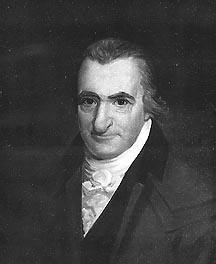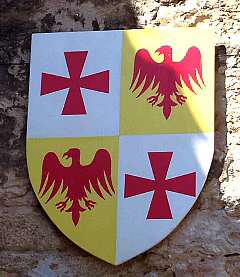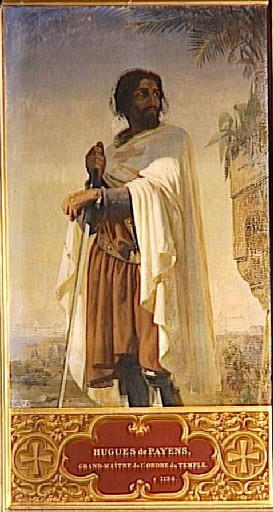

The Paine Family
On this page I will explore Payne/Paine genealogy and historical information about famous Paynes/Paines.
THE Marye Anne OF YARMOUTH
From Hotten's Early American Emigrants we find:
"May 19th, 1637. The examination of Thomas Paine, of Wrentom, in Suffolcke, weauear (weaver), aged 50 yeares (years), and Elizabeth, his wife, ageed (aged) 53 yeares (years), with 6 children, Thomas, John, Marey (Mary), Elizabeth, Dorethry (Dorothy), and Sarah, are desirous to goe (go) for Salem in New England to inhabitt (inhabit)" (Family Tree Maker CD364 American Source Records in England, 1600's-1800's) Broderbund Software, Inc.).
THE MEANING OF THE NAME PAINE:
Paine/Payne/Paynes meant the rustic or countryman, a pagan, or decendant of Payen (villager, later heathen)(Smith, Elsdon,
Paganus was a favorite personal name among the Normans, and in French the name was reduced to Payen, Pain, and Paine. There was a Robert Payen or Paganus in Normandy in 1180, and 1108 (Magn. Rotul. Scaccarii Normannie in the Memoires de la Societe des Antiquaires de la Normandie).
There was a John Pain in England in 1272. From this line came the baronets Payne (Rotuli Hundrederum) (record publication).
AN INFAMOUS PAINE :
Thomas Paine (1737-1809) was born on January 29, 1737; in Thetford, England, and died June 8, 1809, in New York City. Thomas Paine was the son of a poor Quaker corset maker. His father was Joseph Paine (a Quaker) and Frances Cocke Paine (an Anglican). He was self-educated. He was an avid reader from an early age, and by his teens, he was reading books written in Latin.
Thomas married Mary Lambert. She died in childbirth, as did her child. However, Thomas spent the first thirty-seven (37) years of his life in poverty. Thomas Paine tried a few different occupations, such as corset maker, a privateer (in 1756), a Methodist preacher, a grocer, an excise officer (from which he was fired twice), an English teacher, and a writer. It wasn't until 1774 when he arrived in Philadelphia, PA. with letters of introduction from Benjamin Franklin that he seemingly found his way in the world. While in London, Paine caught the attention of Benjamin Franklin, and when Franklin found out he wanted to go to America, Franklin recommended Philadelphia. It was said that Paine had trouble relating to others, but that he was a creative literary genius. He made money as a free-lance journalist for the periodical, The Pennsylvania Magazine.
In Philadelphia, Thomas Paine wrote countless articles, stories, and in 1775, this poem:
Paine is best remembered for his political pamplets. He published Common Sense in 1776, when he was thirty-nine (39) years old. He argued that America had a moral obligation to the world, and that was to declare independence. Congress had already been cautiously moving toward the idea of independence: "Tis time to part." he wrote. Paine's pamplets gained popularity and were the catalyst for more action on the matter of breaking from England. Common Sense sold out in less than two weeks in Philadelphia, within three months, it sold more than 120,000 copies throughout the colonies. Paine's pamplet was either read or heard by almost every American citizen. In the next two years, one-half million copies sold around the world. Paine lurked aroun the halls of Congress and nagged and pestered delegates to vote for independence. People began to toss out loyalists who dominated the state legislature and sent representatives to Congress that supported independence.
Thomas Paine donated all the royalities to the Second Continental Congress (Phillips, Donale T., The Founding Fathers on Leadership. New York: Warner Books, 1997, 60.
Thomas Paine challenged the British view that American colonies needed to be protected by England and that the monarchy/parliament was better than local government. He state that simpler was better and that American economy suffered under England's control. Connecticut merchants and businessmen openly violated the Crown's trade restrictions and navigation acts. Virginia tobacco farmers refused payment to their debt to British creditors. Thomas Paine, in England's eyes, was committing treason. However, he refused to be intimidated by the crown. He even called George III, The "Royal Brute of Britain."
The Declaration of Independence was an act of treason against the government of Great Britain. For that reason, the names of the signers were not revealed.
He also wrote: The American Crisis (December 19, 1776), which is often quoted: "These are the times that try men's souls. The summer soldier and the sunshine patriot will, in this crisis, shrink from the service of his country; but he that stands now, deserves the love and thanks of man and woman...Tyranny, like hell, is not easily conquered; yet we have this consolation with us, that the harder the conflict, the more glorious the triumph." Widely circulated, these pamplets helped raise American morale during a dark period of Revolution.
Paine marched to Anboy, New Jersey, located off the tip of Staten Island, New York; where the British began their invasion. They arrived before the first 9,300 redcoats landed, and he stayed until the fighting went north. Paine then went ot Fort Lee where General Nathaniel Greene appointed him as one of his aides.
Paine traveled between London and France in the late 1780's, and managed to get his cherished invention, an iron bridge, and established himself as a world revolutionary with the publishing of The Rights of Man.
In 1792 Thomas Paine became a French citizen. He was briefly in politics. Paine began The Age of Reason while incarcerated in prison during the French Revolution. The Age of Reason shocked America. They called it the "Atheist's Bible." He made more enemies when he published Letter to George Washington, in which he attacked the military reputation and policies of America's national icon.
For more information on George Washington:
George Washington-Our First President/US Royalty
In 1802 Paine returned to New York City where he spent his last years in poverty, drink, declining health, and social ostracism. He died on June 8, 1809. In 1819 Thomas Paine's remains were taken to England by William Corbett, and eventually knowledge of his resting place was lost.
The above portrait was made from an engraving by Julius R. Ames (Flexner, James Thomas, The Face of Liberty: Founders of the United States. New York: Clarkson N. Potter, Inc, Publisher, 1975.
Another Paine Patriot was Robert Treat Payne, Signer of the Declaration of Independence. For his tree CLICK HERE
JAMES PAINE, ARCHITECT
James Paine was known for restoring "English Country Homes." Some of the homes he worked on were:
Kedleston Hall in Derbyshire, England. Kedeston Hall
Raby Castle in county Durham
Felbrigg Hall in Norfolk County, England.
Wollington at Cambo, England
Paine also designed some interiors here, but in 1765 his appointment was dropped in favor of Robert Adams, a younger architect.
SIR JOSEPH PAINE:
Sir Joseph Paine, Mayor, owned Stranger's Hall in Norwich, a merchant's house. The hosier enlarged and rebuilt the parlour (dining room) in 1659 (Wood, Margaret, The English Mediaeval House. New York: Harper Colophone Books, 1965.).
How these famous Paine might relate to my line is for now unknown.
HUGH DE PAYENS:
One of the most famous Paine/Payne/Payens was Hugues de Payen (1070-1136). Hugh (English spelling) was a French knight from the Champagne region. He was thought to have been born in Chateau Payens, which was located about ten (10) kilometers from Troyes, Champagne, France. Hugh co-founded the Knights Templars as their first Grand Master. With Saint Bernard de Clairvaux, he created the Latin Rule, with because the behavior code of the Templars.
It is thought that Hugh was a vassal of Count Hugh of Champagne, and Hugh went with the Count on the First Crusade. When Hugh de Champagne visited Jerusalem in 1108, Hugh de Payens went with him and remained there. It is this time the the formation of the warrior monks began. Pope Urban II recognized them and used them to protect pilgrims to the Holy Lands. The original knights numbered only nine (9):
Hugh de Payens was the Grand Master of the Knights Templar for almost twenty years.
In 1128, Hugh de Payens visited Scotland and England. He is raised money for his Order. Their first houses (in the British Isles) were established in London, England; and Edinburgh, Scotland. The Scottish house was at Temple, in Midlothian.
Hugh de Payens dies in Palestine in 1136, and his successor, as Grand Master, was Robert de Craon.
MY OWN PAINE LINES:
My own Paine line begins with Philemon Dickerson B: May 7, 1613, who married MARY PAINE who was born on October 12, 1611 in Wrentham, Suffolk County, England). She came to Salem, Essex County, Massachusetts, in 1641. Philemon died March 27, 1672 in Southold, Long Island, New York; and Mary died March 1, 1698 in Southold, Long Island, New York.
Mary Paine was the daughter of Thomas Paine who was born on December 11, 1586 in Wrentham, Suffolk County, England. In one account, he married Elizabeth Margaret Pultenay on November 22, 1610 in Wrentham, Suffolk County, England. Thomas Paine died in 1610 in the Parish of Cooklie, Wrentham, Suffolk County, England. Margaret died on September 16, 1686.
This Paine line is in question.
Here is that line:
Generation One:
Thomas Paine married Katherine Harasant de Cransford, daughter of Thomas Harasant de Cransford. They were married on July 1578 in Cooklie (near Halesworth), Blything, Suffolk County, England.
Katherine Payne, wife of Thomas Paine, died May 18, 1620. Thomas Payne died on April 14, 1631; at age 90/91 years of age.
Generation Two:
Thomas Payne came on the Mary Anne of Yarmouth on August 21, 1637. Thomas Paine was received into the town of Salem, Massachusetts; at the age of 51.
Thomas was listed as a weaver who had come from Wrentham, Suffolk County, England. As stated in generation one, Thomas was born on December 11, 1586. He married Elizabeth---? on November 22, 1610.
Generation Three:
Mary Payne/Paine was born on October 12, 16ll. Mary married Philemon Dickerson, tanner of Salem (1689) and they settled in Southold, Long Island, New York. Philemon died before 1672 in New York.
SOURCES:
The Norman People. London, 1874.
For more on this line go to The Dickerson Family - Table of Contents.
Written and researched by Margaret Odrowaz-Sypniewska, B.F.A.
Painted circa 1805
Through the land let the sound of it flee.
Let the far and near all unite, with a cheer,
In defense of our Liberty Tree."
The Lineage of George Washington
( Pearson, John, The Serpent and the Stag: The Saga of England's Powerful and Glamorous Cavendish Family From the Age of Henry the Eighth to the Present. New York: Holt, Reinhart and Winston, 1983. AND Tyack, Geoofrey and Steven Brindle, Country Houses of England. London" A & C Black, 1994. AND Bence-Jones, Mark, The National Trust Great English Homes: Ancestral Homes of England and Wales and the People Who Lived in Them. New York: British Heritage Press, 1984.).
 ...
... 
The Children of Thomas and Katheran were:
Their children were:
Their Children:
visitor since November 8, 2005
Last updated on April 24, 2016
© 1997 Maggie973@aol.com